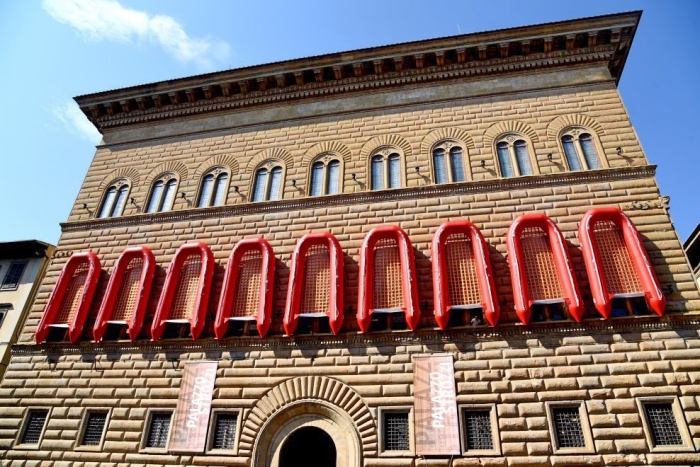The Palazzo Strozzi and Ai Weiwei

Ai Weiwei, Reframe (2016) – Palazzo Strozzi, Firenze. IMAGE SOURCE: firenze.repubblica.it
THE PALAZZO STROZZI AND AI WEIWEI: HISTORIC PALACES AND THEIR RIGHT TO LIVE IN THE PRESENT DAY
Ai Weiwei and the Palazzo Strozzi. 22 orange rubber boats anchored to the Palazzo Strozzi’s windows in Florence which will disgust art lovers, who want to see art always inside a museum.
The first Italian retrospective dedicated to the Chinese artist Ai Weiwei, dissident and persecuted by the government of Beijing for his opinions on the regime, will run at the Palazzo Strozzi, displaying old and new works by the artist, including “Reframe” created with rubber boats used by migrants crossing the Mediterranean Sea.

Ai Weiwei, Reframe (2016) – Palazzo Strozzi, Firenze. IMAGE SOURCE: www.designboom.com
A provocative installation which will obligate people to look at the Palazzo Strozzi, and not to be indifferent to millions of migrants on the run risking their lives. It’s a work which will divide the public into two groups: those who love contemporary art, and those who don’t want for anything in the world that contemporary artists enter historic palaces.
I believe that a dialogue between ancient art and contemporary art is a great opportunity. And you? What do you think about it?
I’m waiting for your comments. In the meantime I’ll tell you what Palazzo Strozzi is, and who Ai Weiwei is.
The Palazzo Strozzi
In 1489 in order to build the Palazzo Strozzi 15 buildings were demolished. Filippo Strozzi wanted to build a majestic palace which had to assert the role the Strozzi family played in Florence.
Even the sale of food was prohibited in the opposite square.
The palace belonged to the Strozzi family until 1937, and now it belongs to the Italian government, and is home to great temporary exhibitions.
Ai Weiwei
Dissident artist and symbol of the struggle for freedom of speech, Ai Weiwei is known worldwide for his political activism linked to his provocative works.
Ai Weiwei is China’s most important living artist, and one of the most influential personalities of our times. In his works the artist plays with tradition and modernity, past, present e future. He uses Chinese materials and traditional Chinese techniques, but at the same time he changes objects, images and Chinese metaphors, opposing contradictions of his people.
Reframe (New Frame)
It’s a work conceived for the facade of the Palazzo Strozzi, and derives from the artist’s commitment to migration and refugees.
Ai Weiwei wants to stir our emotions with the aim of drawing attention to the tragedy lived by people who are risking their lives to reach the continent crossing the sea, in order to escape destruction and war.
What do you think about it? Do you like it, or does the unusual use of a historic palace in Florence annoy you?

Ai Weiwei in mostra a Palazzo Strozzi, Firenze. IMAGE SOURCE: https://www.artribune.com
INFO
Ai Weiwei. Libero
From 23rd september 2016 to 22nd january 2017
Palazzo Strozzi, Florence
Follow me on:
About me
In this blog, I don't explain the history of art — I tell the stories that art itself tells.


